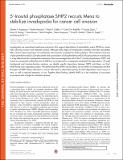| dc.contributor.author | Rajadurai, Charles V. | |
| dc.contributor.author | Havrylov, Serhiy | |
| dc.contributor.author | Coelho, Paula P. | |
| dc.contributor.author | Ratcliffe, Colin D.H. | |
| dc.contributor.author | Zaoui, Kossay | |
| dc.contributor.author | Huang, Bruce H. | |
| dc.contributor.author | Monast, Anie | |
| dc.contributor.author | Chughtai, Naila | |
| dc.contributor.author | Sangwan, Veena | |
| dc.contributor.author | Siegel, Peter M. | |
| dc.contributor.author | Park, Morag | |
| dc.contributor.author | Gertler, Frank | |
| dc.date.accessioned | 2017-05-19T13:48:50Z | |
| dc.date.available | 2017-05-19T13:48:50Z | |
| dc.date.issued | 2016-09 | |
| dc.date.submitted | 2015-01 | |
| dc.identifier.issn | 0021-9525 | |
| dc.identifier.issn | 1540-8140 | |
| dc.identifier.uri | http://hdl.handle.net/1721.1/109203 | |
| dc.description.abstract | Invadopodia are specialized membrane protrusions that support degradation of extracellular matrix (ECM) by cancer cells, allowing invasion and metastatic spread. Although early stages of invadopodia assembly have been elucidated, little is known about maturation of invadopodia into structures competent for ECM proteolysis. The localized conversion of phosphatidylinositol(3,4,5)-triphosphate and accumulation of phosphatidylinositol(3,4)-bisphosphate at invadopodia is a key determinant for invadopodia maturation. Here we investigate the role of the 5′-inositol phosphatase, SHIP2, and reveal an unexpected scaffold function of SHIP2 as a prerequisite for invadopodia-mediated ECM degradation. Through biochemical and structure-function analyses, we identify specific interactions between SHIP2 and Mena, an Ena/VASP-family actin regulatory protein. We demonstrate that SHIP2 recruits Mena, but not VASP, to invadopodia and that disruption of SHIP2–Mena interaction in cancer cells leads to attenuated capacity for ECM degradation and invasion in vitro, as well as reduced metastasis in vivo. Together, these findings identify SHIP2 as a key modulator of carcinoma invasiveness and a target for metastatic disease. | en_US |
| dc.language.iso | en_US | |
| dc.publisher | Rockefeller University Press | en_US |
| dc.relation.isversionof | http://dx.doi.org/10.1083/jcb.201501003 | en_US |
| dc.rights | Creative Commons Attribution-Noncommercial-Share Alike 3.0 Unported license | en_US |
| dc.rights.uri | http://creativecommons.org/licenses/by-nc-sa/3.0/ | en_US |
| dc.source | Rockefeller University Press | en_US |
| dc.title | 5′-Inositol phosphatase SHIP2 recruits Mena to stabilize invadopodia for cancer cell invasion | en_US |
| dc.type | Article | en_US |
| dc.identifier.citation | Rajadurai, Charles V. et al. “5′-Inositol Phosphatase SHIP2 Recruits Mena to Stabilize Invadopodia for Cancer Cell Invasion.” The Journal of Cell Biology 214.6 (2016): 719–734. | en_US |
| dc.contributor.department | Massachusetts Institute of Technology. Department of Biology | en_US |
| dc.contributor.department | Koch Institute for Integrative Cancer Research at MIT | en_US |
| dc.contributor.mitauthor | Gertler, Frank | |
| dc.relation.journal | The Journal of Cell Biology | en_US |
| dc.eprint.version | Final published version | en_US |
| dc.type.uri | http://purl.org/eprint/type/JournalArticle | en_US |
| eprint.status | http://purl.org/eprint/status/PeerReviewed | en_US |
| dspace.orderedauthors | Rajadurai, Charles V.; Havrylov, Serhiy; Coelho, Paula P.; Ratcliffe, Colin D.H.; Zaoui, Kossay; Huang, Bruce H.; Monast, Anie; Chughtai, Naila; Sangwan, Veena; Gertler, Frank B.; Siegel, Peter M.; Park, Morag | en_US |
| dspace.embargo.terms | N | en_US |
| dc.identifier.orcid | https://orcid.org/0000-0003-3214-4554 | |
| mit.license | PUBLISHER_CC | en_US |
| mit.metadata.status | Complete | |
